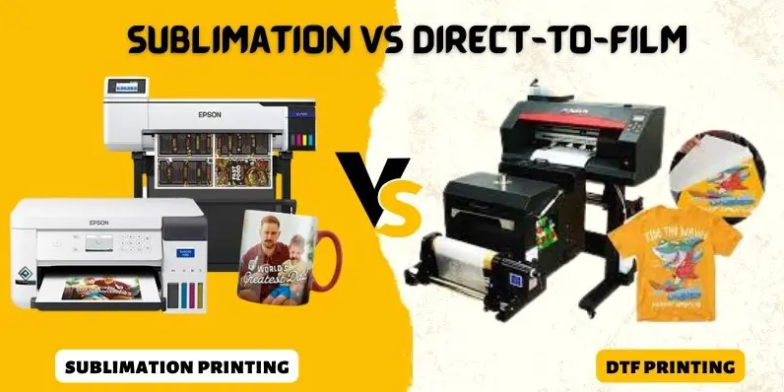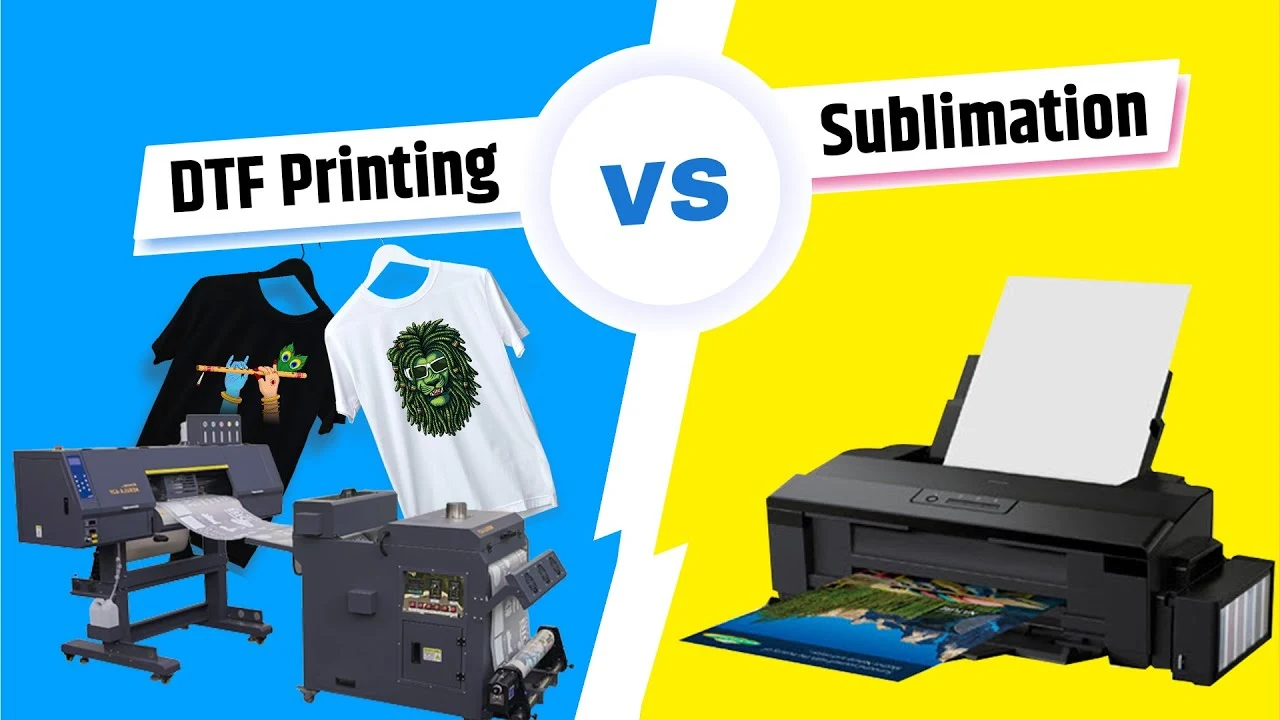Sublimation printing and DTF printing are just some of the unique digital printing styles. Each is suited for particular purposes: sublimation is on and forth with DTF. Here are some of the most outstanding differences between sublimation and DTF printing:
Sublimation printing and Direct-to-Film (DTF) printing are the two most prominent methods of high-quality garment printing. Each of these techniques has its pros and cons and is suitable for specific applications. But what exactly sets DTF apart from sublimation? This guide discusses the durability, color vibrancy, material compatibility, and cost implications of both print techniques.

Table of Contents
What is Sublimation Printing?
Sublimation printing is a digital printing technology dealing with dye transfer from paper to several materials including fabric, ceramic, metal, and plastic using heat. Conversely to classic printing, sublimation doesn’t put ink onto the surface but puts it into the material, producing long-lasting and deep color designs.
Key Features of Sublimation Printing
- Ideal for polyester fabrics and coated surfaces
- Produces highly detailed, vibrant prints
- The design becomes part of the fabric, resulting in a soft feel
- Not suitable for cotton or dark fabrics
Common Uses of Sublimation Printing
- Custom t-shirts and sportswear
- Personalized mugs, phone cases, and keychains
- Home decor like pillows and banners
Key Features of DTF Printing
- Can be used on any fabric type, including cotton, polyester, and blends
- Produces vivid, durable prints with excellent detail
- Prints have a slight texture compared to sublimation
- Requires special transfer film and adhesive powder
Common Uses of DTF Printing
- Cotton t-shirts and hoodies
- Canvas bags and denim
- Performance apparel and sports gear
Comparison of DTF vs sublimation Printing
| Feature | Sublimation Printing | DTF Printing |
|---|---|---|
| Material Compatibility | Best for polyester & coated materials | Works on all fabrics |
| Print Durability | Long-lasting but fades over time | Highly durable with minimal fading |
| Color Vibrancy | Bright and vivid colors | Slightly muted but still strong |
| Feel of Print | Embedded into fabric, no texture | Has a soft, flexible texture |
| Initial Cost | Lower cost for small businesses | Higher initial investment |
| Production Speed | Fast for polyester prints | Slightly longer due to transfer process |
Pros and Cons of Each Printing Method
Pros of Sublimation Printing
✅ Produces high-quality, vibrant colors ✅ Seamless integration with fabric ✅ Ideal for polyester-based products
Cons of Sublimation Printing
❌ Limited to light-colored polyester fabrics ❌ Cannot print on cotton or dark materials
Pros of DTF Printing
✅ Works on all fabric types ✅ Long-lasting and durable prints ✅ Can be used on both light and dark fabrics
Cons of DTF Printing
❌ Requires special films and adhesive powder ❌ Prints may have a slight texture
Cost Comparison: DTF vs sublimation
| Expense | Sublimation Printing | DTF Printing |
| Printer Cost | $300 – $1,500 | $2,000 – $5,000 |
| Ink Cost | $30 – $100 per set | $50 – $150 per liter |
| Transfer Materials | Sublimation paper: $20 – $50 per pack | DTF film & powder: $50 – $200 per set |
| Maintenance | Low | Medium to high |
Which Printing Method is Best for You?
If you primarily work with polyester garments and promotional products, sublimation is a cost-effective and high-quality option. However, if you need a versatile printing solution that works on all fabrics, DTF printing is the better choice for durability and flexibility.
Conclusion
Both have advantages, depending on the products you want to make. If your products are primarily polyester-based materials and you want seamless, high-quality prints, sublimation is an excellent choice. However, for more versatile, long-lasting prints on any fabric, DTF is the better option, although it costs a little more upfront.
The difference between sublimation and DTF is the main factor that will guide your printing business in choosing the right print method.
Frequently Asked Questions (FAQ) DTF vs sublimation
May I use sublimation ink for DTF printing?
No. DTF ink differs from sublimation ink. DTF requires pigment-based inks made specifically for use with adhesive powder and transfer films.
Which of the two lasts longer?
DTF prints are more stable and usually last longer on both cotton and blended fabrics, while sublimation prints fade faster in time with several washes.
Is DTF printing costlier than sublimation?
Yes, it is more expensive because it needs more equipment and special materials for the print.
Can I do DTF printing at home?
Yes, but it needs a standalone DTF printer, transfer film, adhesive powder, and a heat press, thus making it more complex than sublimation printing.
